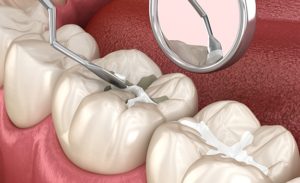WHAT’S THE BEST ?
June 26, 2023
 There have been lots of changes over time in the materials used to restore teeth. Many of the materials I use today were not in existence when I started to practice. The most significant changes have been to materials that are tooth-colored.
There have been lots of changes over time in the materials used to restore teeth. Many of the materials I use today were not in existence when I started to practice. The most significant changes have been to materials that are tooth-colored.
There are very few patients who ask for gold or silver fillings any more. And, while some of these newer materials are tooth colored, there are factors which need to be considered in determining what material is appropriate for each individual situation. The longest lasting restorations I have ever seen are gold done by dentists who really knew the art of working with gold.
As I said last week – The best dentistry is No dentistry. Prevention of decay and other factors that require teeth to be restored is the best defense to not needing restorative dental work. Keeping up with maintenance cleaning appointments and listening to your dental team’s recommendations regarding diet, homecare and other forms of prevention, such as nightguard use, is key to avoiding many dental problems.
One of my favorite quotes in dentistry comes from a pioneer dentist who was killed in a plane crash back in the 1970’s named Bob Barkley. Aside from being the one who said “The best dentistry is No dentistry”, he also said, “The goal of dentistry is to make the patient worse at the slowest possible rate”. I think about this quote all the time when making recommendations and treating patients. Sometimes it leads me to recommend more extensive treatment, and other times it leads me to not recommend any treatment at all, even despite apparent need. It really depends on many factors.
Dr. Barkley also coined the phrase “co-diagnosis” which refers to the patient taking an active role in their dental health. It is the role of the dentist to not only educate the patient on their specific situation and different options for care, but to also extract (pun intended) from the patient their goals for their dental health. It is so important to think beyond the immediate fix sometimes. Taking the time to talk to patients about why things are happening, and about their choices for prevention and treatment, allows patients to become active participants in their health.
There are barriers to this model. One of the biggest issues facing both dentists and patients today is the role of patient’s dental benefit companies. The trend is less costly plans with fewer benefits and restrictions on providers, because to get the maximum (or sometimes any) benefit, the patient must seek a participating dentist provider. I would encourage staying away from any dental plan that forces you to see specific providers. You should always have a choice.
My simple suggestion is to take a more active role in your own dental health. Think forward and ask your dentist or dental hygienist about things that can make your situation worse at the slowest possible rate. You very well may be doing fine, or just need a couple of tweaks to your home care regimen. Find a dental team that listens to your concerns and takes the time necessary to establish a plan that makes sense and you are on board with.
Dr. St. Clair maintains a private dental practice in Rowley dedicated to health-centered family dentistry. He has a special interest in treating snoring, sleep apnea and TMJ problems. If there are certain topics you would like to see written about or questions you have please email them to him at jpstclair@stclairdmd.com
WHAT’S IN YOUR MOUTH?
June 19, 2023
 Dentistry is full of old, new, and emerging technology. For example, the different ways to use dental implants over the last 30 years has been a major game changer in the field of dentistry. Likewise, CAD/CAM technology (computer-aided design and manufacturing of dental restorations) has seen steady growth over the same 30 years. Here is a little background on the some of the reasons this technology is here to stay.
Dentistry is full of old, new, and emerging technology. For example, the different ways to use dental implants over the last 30 years has been a major game changer in the field of dentistry. Likewise, CAD/CAM technology (computer-aided design and manufacturing of dental restorations) has seen steady growth over the same 30 years. Here is a little background on the some of the reasons this technology is here to stay.
Let me start by saying that the best dentistry is NO dentistry. Prevention of decay and other destructive things that happen to teeth is the best line of defense. Having said that, the fact of the matter is, there are many people who need things done to their teeth to preserve them for their lifetime.
Dental amalgam (silver filling) was introduced to dentistry well over 100 years ago. It proved to be one of the major contributors to saving many teeth that were in need of repair. Dental amalgam is a very hard material which can last for many years. However, there are many aspects of dental amalgam that are undesirable. It is ugly, tooth preparation needs to be more aggressive to retain it, the material breaks down over time, and it contains mercury. Dental amalgam is not used in most of Europe and has been dying a slow death in the United States over the last 30 years.
Progressive dentists, who were interested in providing better, longer-lasting dentistry, learned the skill of using gold. Despite the way you feel about gold in your mouth, done well, gold is still one of the best, most biocompatible and longest lasting materials used to protect teeth. Gold has also been dying a slow death mainly due to the fact that patients prefer tooth-colored restorations.
Then composite resin was introduced. It started as a filling material used to fill cavities on front teeth and eventually evolved enough to be used in back teeth. Dental composite, an ultraviolet light-cured resin, is the main direct restorative material used in dentistry today. It has become the amalgam replacement. It is relatively esthetic, chemically bonds to tooth structure, and allows for much more conservative tooth preparation. However, it is much softer than natural tooth structure and therefore has its limitations.
Dental amalgam and composite are what we in dentistry call direct restorative materials. This means that a cavity preparation is made and the material is directly placed in the tooth. This is different than gold or porcelain which are considered indirect materials. These are manufactured and then cemented or bonded to tooth structure.
When a tooth needs a larger filling, specifically one that needs to cover the cusp of a tooth due to fracture, risk of fracture due to cracks, or has undergone extensive destruction due to decay, direct materials like composite are not indicated due to wear factors. Indirect materials are more appropriate and are much longer lasting.
The advantage of CAD/CAM is the ability to provide stronger, esthetic, indirect materials in addition to being more conservative in tooth preparation. Next week I will continue this subject with the specific uses of this technology.
Dr. St. Clair maintains a private dental practice in Rowley dedicated to health-centered family dentistry. He has a special interest in treating snoring, sleep apnea and TMJ problems. If there are certain topics you would like to see written about or questions you have please email them to him at jpstclair@stclairdmd.com
VISUALIZE CHANGE
June 12, 2023
 I remember seeing a commercial for a cholesterol medication in which the person playing the doctor says, “I wish my patients could see what I see.” I think there are two ways to look at that statement.
I remember seeing a commercial for a cholesterol medication in which the person playing the doctor says, “I wish my patients could see what I see.” I think there are two ways to look at that statement.
The commercial showed an image of animated artery walls clogging with particles of plaque clinging to one another, making the opening of the artery smaller and smaller. This is a visual that is easy to understand.
The second, and more subtle way to take this statement, is the doctor wishing that patients could see what happens to people over time, with and without compliance to taking medication or changing their diet. If patients could only understand and use the vast experiences of the doctor to make better decisions for themselves, wouldn’t everyone choose to do all the “right” things for a better and healthier life? Conventional wisdom would say “yes”, but reality says something different.
I have been photographing teeth since dental school…..a long time ago. So long ago, that I had to take the film to be developed to have slides made. When I tell a patient that I am going to take a series of pictures of their teeth, the response I often hear is, “I just had x-rays taken.” When I explain that they are pictures and not x-rays, it is not uncommon for the patient to ask, “Why?”, or say, “No one has ever done this before.” I explain that the photographs are used for documentation and communication.
Showing a patient visual images of their own teeth is by far the most powerful tool I use in practice. Patients often get frustrated when a dentist explains and recommends treatment they can’t see. You should be able to see and understand why something is recommended, even without a dental degree. Pictures help in telling the story, and help patients make better informed decisions.
When displaying the images and giving the patient a tour of their own mouth, the patient will often say, “Wow, that doesn’t look good. I can’t believe that is in my mouth.” Photographs help in explaining why things look the way they do. From there it is easier to explain to patients what to expect in the future. Photographs are invaluable for this exercise, and most patients appreciate being able to see what I see.
If a patient has not been to a dentist in a while, or is seeing a new dentist who is doing a complete exam, photographs help patients with decision making. It is important to try to get the patient to look beyond the pictures, and envision where they want to be 5, 10, 20+ years down the road. The goal is for the dentist to tie their experience together with where the patient is currently, where they are headed, and give them the opportunity to potentially change the course of their future.
This approach may be different for some patients. It is easy to get overwhelmed by any new approach, but it is important to keep an open mind. Photographs of your own mouth in the dental office are an important part of the doctor/patient relationship, because communication is the key to any relationship.
You, as a patient, should look beyond today and make choices for ANY aspect of your health based on where you want to be in the future. Take advantage of the knowledge you gain from all your experiences, and make decisions that you feel are right for you.
Dr. St. Clair maintains a private dental practice in Rowley dedicated to health-centered family dentistry. He has a special interest in treating snoring, sleep apnea and TMJ problems. If there are certain topics you would like to see written about or questions you have please email them to him at jpstclair@stclairdmd.com
Summer Foods You Can Enjoy with Dental Implants
June 9, 2023
 If you’ve recently invested in dental implants, you’ve made a wise decision. You can enjoy many summer foods you might have avoided, thanks to your new teeth. Dental implants are unlike any other tooth replacement method because they have the support of your jawbone to regain 70% of your natural biting force. Although you can eat just about anything, your implant dentist recommends a few precautions to protect your investment.
If you’ve recently invested in dental implants, you’ve made a wise decision. You can enjoy many summer foods you might have avoided, thanks to your new teeth. Dental implants are unlike any other tooth replacement method because they have the support of your jawbone to regain 70% of your natural biting force. Although you can eat just about anything, your implant dentist recommends a few precautions to protect your investment.
(more…)
DO YOU HAVE JAW PAIN?
June 5, 2023
 There are many people who suffer with pain involving some area of the head. Toothaches can cause pain, but these are mostly avoidable with proper diet, home care and regular visits to your dentist. Teeth can also play an indirect role in facial/head pain.
There are many people who suffer with pain involving some area of the head. Toothaches can cause pain, but these are mostly avoidable with proper diet, home care and regular visits to your dentist. Teeth can also play an indirect role in facial/head pain.
Orofacial pain includes a number of clinical problems involving the chewing (masticatory) muscles and/or temporomandibular joints (TMJs). Problems can include TMJ discomfort involving muscle spasms in the head, neck, shoulders and/or jaw, migraines or other types of tension headaches, pain with the teeth, face or jaw; and can even play a role in anxiety and/or depression.
You swallow approximately 2,000 times per day, which causes the upper and lower teeth to come together and push against the skull. People who have an unstable bite, missing teeth, or poorly aligned teeth can have trouble because the muscles work harder to bring the teeth together, causing strain. People with seemingly good teeth/bite are also susceptible. Pain can also be caused by clenching or grinding teeth, trauma to the head and neck, or poor ergonomics. Temporomandibular disorders (TMD) affect more than 10 million Americans. Your TMJ’s are located where the skull connects your lower jaw to the muscles on the sides of your head and face controlling the joint’s movements. Women between the ages of 20 and 40 are often more frequent sufferers because of the added estrogen in their bodies.
One in eight Americans suffers from headaches. Experts estimate that 80 percent of all headaches are caused by muscle tension, which may be related to the bite. Clenching the jaw muscles creates tension in the muscles that close the jaw, the main one of which is the temporalis muscle. Signs that may indicate a headache from dental origin include: pain behind the eyes, sore jaw muscles or “tired” muscles upon awaking, teeth grinding, clicking or popping of the jaw joints, head and/or scalp is painful to the touch, earaches or ringing, neck and/or shoulder pain, and dizziness. Keep in mind that in a 24-hour period of time, your teeth should only touch 10 minutes total. If you clench or grind your teeth, your teeth are touching much more than that and I can promise you that something in the masticatory system is being affected.
Sleep disorders can also play a role. I am not just talking about sleep apnea. There are a wide range of sleep disorders and some of them will cause people to clench and/or grind as a defense mechanism of the body to achieve proper air flow.
Dentists have a variety of ways to help relieve orofacial symptoms. One way to treat these problems is called an orthotic, or splint, that is worn over the teeth to help stabilize the bite; kind of like an orthotic some wear in their shoes for alignment and balance when standing. Permanent correction may require equilibration (reshaping teeth), prosthetic dentistry and/ or orthodontics. Many use a splint on a daily basis to avoid having these other treatments done.
Orofacial pain can range from tolerable to debilitating. Maintaining or correcting your bite ensures optimal health, and proper care will help reduce or eliminate orofacial pain or discomfort. If your dentist can not help you, ask for a referral.
Most important lesson of the day: The optimal rest position of the jaw (minus the 10 minutes the teeth touch in 24 hours) is lips together, teeth slightly apart, the tip of the tongue resting just behind your upper front teeth, and you should be breathing through your nose.
Dr. St. Clair maintains a private dental practice in Rowley dedicated to health-centered family dentistry. He has a special interest in treating snoring, sleep apnea and TMJ problems. If there are certain topics you would like to see written about or questions you have please email them to him at jpstclair@stclairdmd.com







